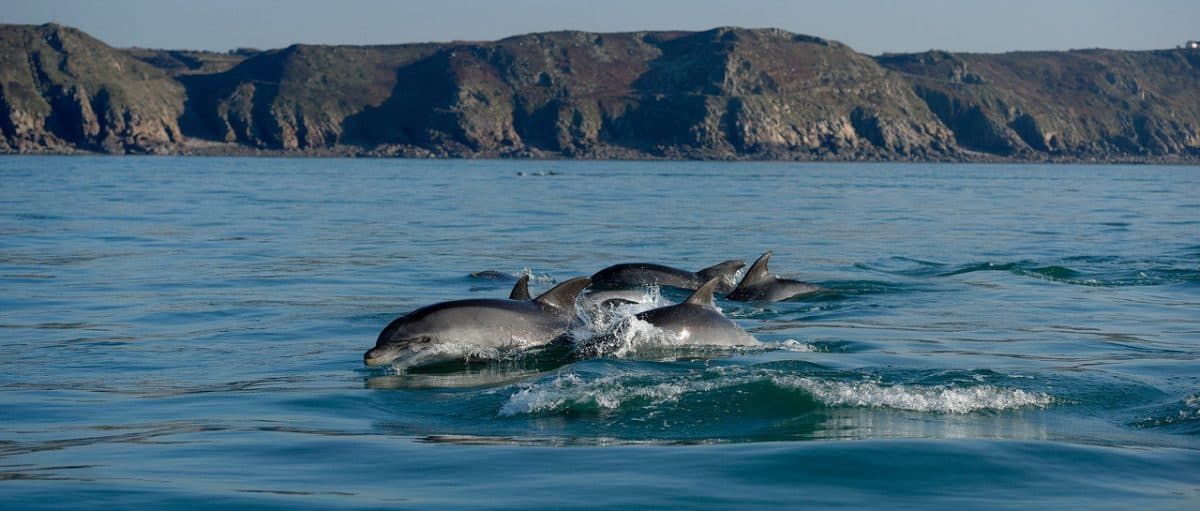
Dolphins in the English Channel are latest pollution victims with some infected by chemicals banned 40 years ago.
High levels of industrial chemicals are building in the blubber and skin of one of the largest coastal populations in Europe, reveals a new study.
Concentrations of mercury found in 82 wild dolphins in the Channel are among the biggest recorded. Skin biopsies were taken during boat surveys.
Corresponding author Dr Krishna Das, a zoologist at the University of Liege, Belgium, said toxic organic pollutants can be detected even in the deepest dwelling marine life.
Most, particularly those containing chlorine, were banned from developed countries in the 1970s and 1980s.
Dr Das said: “These organic compounds are able to dissolve in fats and oils, and consist of the by-products of various industrial processes and pesticides, among others.
“Bottlenose dolphins are often used to study levels of environmental pollutants, as the organic compounds accumulate within their thick layer of fatty tissue.”
The chemicals known as PCBs (polychlorinated biphenyls) pose a serious threat to wildlife and humans.
They were used as a refrigerant as they are difficult to burn and have been banned for 40 years.
But they are extremely durable, remaining in ecosystems even four decades after being outlawed.
The dangerous chemical accumulates at the top of the food chain and has a disastrous impact on an animal’s fertility and immune system.
Recent research has suggested the long-lasting man-made pollutant could lead to the disappearance of half of the world’s killer whales in the next 30 years.
So Dr Das and colleagues assessed levels of PCBs and mercury in the skin of free-ranging bottlenose dolphins inhabiting the Normanno-Breton Gulf in the English Channel.
The study, published in the journal Scientific Reports, found large amounts in the blubber of the loveable sea creatures.
They were predominantly made up of chlorine-containing compounds from industrial fluids – comprising more than 91 percent of the organic chemicals in their skin.
What’s more levels of mercury in skin samples were similar to those previously described for bottlenose dolphins in the Mediterranean Sea and Florida Everglades – areas notorious for contamination.
The pollutants weaken their immune system. They face higher rates of illness and disease than captive counterparts.
In humans, this kind of chronic immune response has been linked to cancer, heart disease and increased vulnerability to infectious disease.
Dr Das said: “The bottlenose dolphin is a relevant species for examining environmental contamination trends in coastal areas.
“The species is widely distributed in estuarine and nearshore waters, is a long-lived species high in the marine food web and a thick layer of blubber in which pollutants accumulate.”
She said previous risk assessment investigations on the potential effect of PCB exposure suggested they were likely to harm survival of calves – and reduced population growth.
About 420 coastal bottlenose dolphins live in the the Normanno-Breton Gulf around the Channel islands.
Dr Das said: “The reported concentrations are among the highest reported for cetaceans.
“We strongly recommend the Normanno-Breton Gulf be a special area of conservation candidate because it contains the last large European population of bottlenose dolphins.”
The Bottlenose Dolphin is one of the most threatened cetacean species in Europe – and consequently has extensive legislative protection.
Dr Das added: “The bottlenose dolphins in European waters are protected by the Habitats Directive.
“Their conservation requires the creation of special areas of conservation and the need for strict protection.
“Despite this European directive, human activities are increasing in the Normanno-Breton Gulf.
“The potential threats include pollutants, noise pollution, particularly construction noise, disturbance by tourism activities and by-catch.
“Bottlenose dolphins have declined in the northeast Atlantic. The historic stranding data in Europe suggest coastal bottlenose dolphins became locally extinct or depleted in the late 1960s to the mid-1970s, including those in the UK and the Dutch coast.
“The last member of a resident bottlenose dolphin population in Arcachon, France, died in 2001, and the small resident bottlenose dolphins group in Portuga declined over several decades due to low calf survival over several decades.”
A recent study of bottlenose doplhins in US waters identified emerging infectious diseases, tumours, antibiotic resistant bacteria and alarmingly high levels of contaminants.
As large predators near the top of the food chain, dolphins accumulate any toxins ingested by their prey.